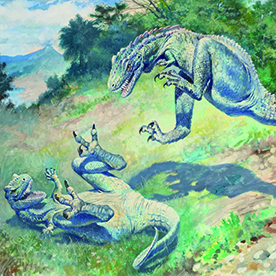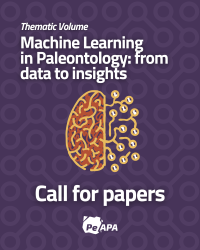PALEOART TRAJECTORIES AND MEANINGS
DOI:
https://doi.org/10.5710/PEAPA.08.04.2024.478Keywords:
History of Paleontology, Museum, Paleoart Aesthetics, Paleoart CommunicationAbstract
Every paleoart work represents living beings, objects of paleobiological studies framed in a space and time observed by us, who are also spatiotemporally bounded. The reasons for the historical importance of paleoart are assessed, inferring it is the result of the triple interaction between the scientific, artistic, and social spheres. By exploring the role played by social contexts and popular culture in paleoart, five stages are considered: (1) scientific illustrations, (2) narratives linked to the beginning of paleontology as a discipline, (3) the emergence of didactic museums, (4) paleoart and the independence of paleoartists, and (5) popular involvement and social networks. The paradigms underlying these stages highlight how emotions, teaching, pedagogy, and the demands of popular culture are present, to a greater or lesser extent, in paleoart aesthetics. Finally, to understand what paleoart communicates, the axes of spatiality are used to capture the distinct levels of information conveyed by its productions.
References
Alba-Tercedor, J, y Alba-Alejandre, I. (2019). Comparing micro-CT results of insects with classical anatomical studies: The European honey bee (Apis mellifera Linnaeus, 1758) as a benchmark (Insecta: Hymenoptera, Apidae). Microscopy, Wiley Analytical Science.
Ansón M., Hernández Fernández, M. (2013). Artistic reconstruction of the appearance of Prosantorrhinus Heissig, 1974, the teleoceratine rhinoceros from the Middle Miocene of Somosaguas. Spanish Journal of Palaeontology, 28(1), 43–54. https://doi.org/10.7203/sjp.28.1.17815.
Ansón, M., Hernández Fernández, M., Saura, P. A. (2015). Paleoart: term and conditions. Comunicación presentada en el XIII Encuentro en Jóvenes Investigadores en Paleontología (XIII EJIP): Cercedilla, 15–18.
Ansón, M., Pernas Hernandez, M., Menéndez Muñiz, R., Saura Ramos, P.A. (2016). Lineas Actuales de Investigación en Paleoarte. I Encuentro de Paleoarte, Madrid 146 pp.
Antón, M., Sánchez, I.M. (2004). Art and science. The methodology and relevance of the reconstruction of fossil vertebrates. P. 74–94. En: Enrique Baquedano Pérez, Susana Rubio Jara (coords.) Homenaje a Emiliano Aguirre, Vol. 2, Paleontología. Comunidad de Madrid, Museo Arqueológico Regional ISBN 84–451-2654-7
Antón, M. (2016). El paleoartista perplejo. En: Ansón, M., Pernas Hernández, M., Menéndez Muniz, R. & Saura Ramos, P. A. Eds. Líneas Actuales de Investigación en Paleoarte 146 pp., Madrid, España.
Argot, C. (2008). Changing Views in Paleontology: The Story of a Giant (Megatherium, Xenarthra). In: Sargis, E.J., Dagosto, M. (eds). Mammalian Evolutionary Morphology. Vertebrate Paleobiology and Paleoanthropology Series. Springer, Dordrecht. https://doi.org/10.1007/978-1-4020-6997-0_3
Arnold, D. (1996). La naturaleza como problema histórico. El medio, la cultura y la expansión de Europa. 1ª reimpresión en castellano. Fondo de Cultura Económica.
Barreiros, J., Ramos, O., Castelo, L., Garvía, A. (2019). Los dioramas de martín pescador de José María Benedito en el MNCN. Natural Mente, 23. https://www.mncn.csic.es/sites/default/files/2019-09/04_taxonomia.pdf.
Biss, L. (2017). Microsculpture: The Insect Photography of Levon Biss. Museum of Natural History, University of Oxford. https://oumnh.ox.ac.uk/microsculpture.
Buffetaut, E. 1991. Fósiles y hombres. Editorial Plaza y Janés, Muy Interesante.
Buscalioni, A.D. (2015). El Paleoarte, entre arte público y cultura popular. eVolución, 10(2), 71–81.
Cain, V. (2010). The direct medium of the vision: visual education, virtual witnessing and the prehistoric past at the American Museum of Natural History, 1890-1923. Journal of Visual Culture, 9, 284. https://doi.org/10.1177/1470412910380334
Carvalho, I., Leonardi, G. (2022). The Invisibles of Science and the Paleontological Heritage: the Brazilian Study Case. Geoheritage, 14, 23 pp. 10.1007/s12371-022-00737-1
Cassirer, E. (1948). La polémica del vitalismo. El problema del conocimiento IV. 6ª reimpresión en español. Fondo de Cultura Económica, México.
Celeskey, M. D. (2019). [Review of The Palaeoartist’s Handbook: Recreating prehistoric animals in art, by Mark D. Witton]. Palaeontologia Electronica, 22, Issue 1; 1R:2p; palaeo-electronica.org/content/2019/2438-review-the-palaeoartist-s-handbook
Cooke, S. (2021). Victorian cryptozoology: the great sea serpent and its cultural representations. https://victorianweb.org/history/cultural/seaserpent/cooke.html
Caprotti, E. (1980). Mostri, Draghi e serpenti nelle silografie dell´opera di Ulisse Aldrovandi e dei suoi contemporanei. Gabriele Mazzotta Editore.
Chasmosaurus (2019). David Orr: The survey of Paleoartists, Appendix B. Paleoart Influences. https://chasmosaurs.com/survey/#ap-b.
Clements, T., Atterby, J., Cleary, T., Dearden, RP., Rossi, V. (2022). The perception of palaeontology in commercial oof-the shelf video games and an assessment of their potential as education tools. Geoscience Communication, 5, 289–306. https://doi.org/10.5194/gc-5-289-2022
Cognitoys. (2020). Educational smart Dinosaurs, with AI-technology. https://grupoadd.es/el-robot-cognitoys-dino
Coiro, M. (2022). Category: Palaeobotany for Paleoartists. An interview with Rebecca Dart. https://mariocoiro.blog/category/palaeobotany-for-paleoartists/
Cortázar-Rodriguez, FJ. (2014). Imágenes rumorales, memes y selfies: elementos comunes y significados. Iztapalapa Revista de Ciencias Sociales y Humanidades, 77 (35), 191–21.
Cunningham, J.A., Rahman, I.A., Lautenschlager, S. Rayfield, E.J., Donoghue, P.C.J. (2014). A virtual world of paleontology. Trends in Ecology & Evolution, 29 (6), 347–357.
Daston, L. (2011). Breve historia de la atención científica. Editorial La Cifra, México.
Deloche, B. (2001). El museo virtual. Ediciones Trea.
Dell, Ch. (2010). Monstruos. Un bestiario del mundo extraño. Editores Lundwerg.
Espinosa Hernández, R. (2020). El proyecto de espaciología de Henri Lefebvre. Cuadernos de Geografía: Revista Colombiana de Geografía, 29 (2), 505–525. https://doi.org/10.15446/rcdg.v29n2.80702
Fallon, R. (2021). Our image of dinosaurs was shaped by Victorian popularity contests. https://theconversation.com/our-image-of-dinosaurs-was-shaped-by-victorian-popularity-contests-130081
FamousFix. (2008). Paleoartist list. https://m.famousfix.com/list/paleoartists
Frąckiewicz, M. (2023). The Role of AI in Advancing the Field of Paleontology. Artificial Intelligence, TS2 Space, May. https://ts2.space/en/the-role-of-ai-in-advancing-the-field-of-paleontology/.
Gaudant, J., Bouillet, G. (2005). La paléontologie de la Renaissance. https://www.annales.org/archives/cofrhigeo/paleontologie-renaissance.html
Grasso, G. (2021). Un viaje en tres dimensiones. Fundación Museo de La Plata, Museo, 33, 27–34.
Hallett, M. (1986). The scientific approach of the art of bringing dinosaurs back to life. Pp. 97–113. En: Czerkas, S.J. y Olson, E.C. (Eds.). Dinosaurs Past and Present 1. Natural History Museum of Los Angeles Count in association with Univ. Washington Press.
Henderson, M. (2008). 50 Genetics ideas. Quercus Publishing.
Hendry, L. (2021). Bringing a Neanderthal to life: the making of our model. https://www.nhm.ac.uk/discover/bringing-a-neanderthal-to-life-the-making-of-our-model.html
Herrero, D., del Castillo, H., Monjelat, N., Garca-Varela, A., Checa, M., Gómez, P. (2014). Evolution and natural selection: learning by playing and reflecting, Journal of New Approaches in Educational Research (NAER Journal), 3, 26–33.
Huxley, H. (1906). Man´s place in nature and other essays. JM Dent and Sons. London.
Hui-Chuan, Ch., Chuan-Kun, H., Ming-Chyuan, H. (2006). A new Communication model in Natural History Museums. Paper at the conference: New Roles and Missions of Museums Taipei: INTERCOM (International Committee on Management), November 2-4 http://www.intercom.museum/documents/3-5chen.
Jenkins, H. (1992). Textual Poachers, Television Fans and Participatory Culture. Studies in Culture and Communication, Rourledge, New York.
Kastner, J. (2012). Nature. Documents of Contemporary Art. Whitechapel Gallery, London. The MIT Press Cambridge, Massachusetts.
Kwon, M. (2004). One Place after another: sitespecific art and locational Identity. Pp. 100–137. En: From Site to Community in New Genre Public Art: the Case of Culture in Action. MIT Press. Cambridge.
Lescaze, Z., Ford, W. (2017). Paleoart. Visions of the Prehistoric Past. TASCHEN, First Edition.
Lampadius, S. (2012). "Evolutionary Ideas in Arthur Conan Doyle's The Lost World". Der andere Conan Doyle. Internationale Tagung am 20. und 21. Mai 2011 in Leipzig Frankfurt. Peter Lang 2012, 68–97.
Lefebvre, H. (1980). La presencia y la ausencia. Contribución a la teoría de las representaciones. Edición 2006. Fondo de Cultura Económica.
León, A. (1995). El museo. Teoría, praxis y utopía. Cuadernos Arte Cátedra, Fernandez Ciudad SL.
Leighton, G. (2018). Did the Teutonic Orden create a sacred landscape in thirteenth-century Prussia? Journal of Medieval history, https://doi.org/10.1080/03044181.2018.1490918
Lizarraga, X., Ponce de León, A., Vera J. L. (coord.). (2012). Escenarios evolucionistas. Encuentros, contextos soliloquios. Instituto Nacional de Antropología e Historia. México.
Marinas, J.M. y Santamarina, C. (2015). El bazar americano. En las exposiciones universales. Editorial Biblioteca Nueva, SL, Madrid.
Monnin, V. (2021). [Article Review: Paleoaesthetics ad the practice of Paleontology, Derek D. Turner. 2019. Cambridge University Press]. Earth Sciences History, 40 (1), 284. Gale Academic OneFile. link.gale.com/apps/doc/A662784441/AONE?u=anon~cb7ba516&sid=googleScholar&xid=f069317b.
Morosi, J.A. (2004). Los creadores del edificio del Museo de La Plata y su obra. 97 pp Fundación Museo de La Plata Francisco Pascasio Moreno, La Plata.
Moya, A. (2014). Biología y Espíritu. Editorial Sal Terrae.
Palacios, R.SJ., Isasmendi, E., Pereda-Suberbiola, X., Sáez-Benito, P., Navarro Lorbés, P., Ferrer Ventura, M., Torices, A. (2021). Pasado, presente y perspectivas futuras de la paleontología de dinosaurios en La Rioja. Enseñanza de las Ciencias de la Tierra, 37–47. https://raco.cat/index.php/ECT/article/view/414013/508829.
Rudwick M.J. S.(1972). El significado de los fósiles. Edición 1987, Herman Blumen.
Rupérez, J. (2022). Macro Extremo, Wix.Com. https://quenoteam2.wixsite.com/macro/about-me
Salgado, L. (2011). La Evolución biológica en el pensamiento y la obra de Florentino Ameghino. Asociación Paleontológica Argentina publicación Especial 12, Vida y obra de Florentino Ameghino, 121–135.
Sanz, J.L. (1999). Mitología de los dinosaurios. Editorial Taurus.
Sachiko-Kusukawa, (2013). Drawings of fossils by Robert Hooke and Richard Waller. Published:03 April 2013 https://doi.org/10.1098/rsnr.2013.0013 Notes Rec. R. Soc. (2013) 67, 123–138. https://www.mncn.csic.es/sites/default/files/2019-09/04_taxonomia.pdf
Saurian Game (2017). Urvogel Games, LLC. https://sauriangame.squarespace.com/
Schnaith, N. (2011). Lo visible y lo invisible en la imagen fotográfica. La Oficina Ediciones, Serie Bauhaus.
Strong, T. (2008). A review of Lorraine Daston and Peter Galison´s objectivity. The Weekly Qualitative Report, 1 (10), 62–66.
Skov, L., Peyrégne, S., Popli, D. et al. (2022). Genetic insights into the social organization of Neanderthals. Nature, 610, 519–525. https://doi.org/10.1038/s41586-022-05283-y
Villoro, L. (1985). El concepto de ideología. 2ª ed., (2007). Colección Biblioteca Universitaria de Bolsillo.
Yan, G., Xin. H. (2022). Practical research on Artificial Intelligence algorithms, Paleontology, Data mining, and Digital restoration of public information. Computational Intelligence and neuroscience, 28. DOI: 10.1155/2022/3068686.
Witton, M. P. (2017). [Review of Paleoart: Visions of the Prehistoric Past, written by Zoë Lescaze and Walton Ford]. Palaeontologia Electronica, 20 (3), 3R:4p; palaeo-electronica.org/content/2017/2031-review-paleoart
Witton, M.P. (2018). The Palaeoartist’s Handbook: Recreating prehistoric animals in art. The Crowood Press.
Witton, M., Ellinor, M. (2022). The Art and Science of the Crystal Palace Dinosaurs. The Crowood Press. 192 pages. ISBN: 9780719840494 192 p.

Additional Files
Published
Issue
Section
License
Copyright (c) 2024 Ángela D. Buscalioni

This work is licensed under a Creative Commons Attribution-NoDerivatives 4.0 International License.
Authors retain copyright and grant the journal right of first publication with the work simultaneously licensed under a Atribución/Reconocimiento 4.0 Internacional that allows others to share the work with an acknowledgement of the work's authorship and initial publication in this journal.
















